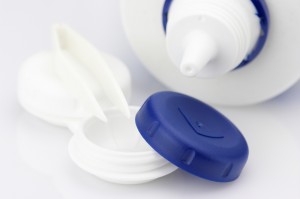9/18/14
Proper contact lens care is essential for the best contact lens wearing experience. Mr. Ward, Director of the Emory Contact Lens Service has shared some valuable information about taking care of your contact lens in the article below. On Tuesday join us for additional tips for people who wear contact lenses and wear cosmetics.
Contact lenses provide alternatives to spectacles, and contact lens wearers report better peripheral vision, depth perception and overall vision quality. Contact lenses can correct near-sightedness, far-sightedness, astigmatism and even correct the need for reading glasses. They are also used to manage some ocular surface diseases.
Contact lenses fall into two basic material types: soft contact lenses (SCL) and rigid gas-permeable (GP) lenses. Soft lenses account for the great majority of the contact lens market. GP lenses require more precise fitting and are often used as specialty devices to correct high prescriptions and/or to manage various ocular disorders and may require longer lens-adaptation time. Regardless of lens type, careful attention to lens care instructions can provide good vision and life-long lens wearing comfort.
Proper lens care depends on the lens type, wearing schedule and other factors. Single-use or daily-disposable soft lenses are prescribed to be worn once and discarded. This is theoretically the safest lens wearing modality in that no lens cleaning, lens care or storage case is required for this modality. Other daily wear soft lenses may be replaced every 2 weeks, monthly or by other schedule. Any and all lenses that are removed each day must be cleaned and disinfected prior to their reuse. Your eye care practitioner should provide specific instructions relative to your lens wear and care needs. General lens care instructions and Dos and Don’ts are bullet-listed below.
A word of caution –
Contact lens wear is quite safe as long as proper lens and storage case care are followed. However, improper lens wear and care can put the lens wearer at risk for serious consequences. Sight-threatening microbial keratitis (corneal ulcer) is the most significant adverse event associated with contact lens wear and is largely preventable. The contact lens storage case is the most likely potential reservoir for contact lens related ocular infections. Therefore, lens storage case care should be high on the list of important lens wearing instructions. Contact lens cases are not meant to be family heirlooms; cases should be replaced regularly, at least every 1-3 months.
The Bullet List of Contact Lens Care Recommendations
- Hand washing: Always wash your hands before handling contact lenses. Use mild, basic soap and avoid antibacterial, deodorant, fragranced or moisturizing liquid soaps (many liquid soaps have moisturizers that can contaminate your contacts from handling).
- Cleaning, rinsing, and disinfecting: Digital cleaning (rubbing the lens with your finger in your palm) removes dirt and debris and prepares the lens surfaces for disinfection. Rub & rinse thoroughly, even if the product is labeled “No Rub”. Lens storage solutions contain chemicals that inhibit or kill potentially dangerous microorganisms while the lenses are soaked overnight.
- Contact lenses should be cleaned when removed from the eye.
- Do not re-use old solution or “top-off” the liquid in the lens storage case. Empty the storage case daily and always use fresh solution.
- Do not use lens care products beyond their expiration dates. Discard opened bottles after 28 days.
- Do not allow the tip of the solution bottle to come in contact with any surface, and keep the bottle tightly closed when not in use.
- Do not transfer contact lens solution into smaller travel-size containers.
- Keep your contact lens storage case clean (inside and out).
- All lens storage cases should be emptied, rinsed, wiped, and air-dried between uses.
- Keep the contact lens case clean and replace it regularly, every one to three months.
- Do not use cracked or damaged lens storage cases.
- Take care to remove residual solution from surfaces of lens case and solution bottles.
Other Dos and Don’ts
- Do not wear your lenses during water activities (swimming, hot tubs, showering, etc).
- Soft contact lenses should not be rinsed with or stored in water. Soft lenses will change size and shape if exposed to water.
- Do not put your lenses in your mouth.
- Do not use saline solution or re-wetting drops in an attempt to disinfect lenses. Neither is capable of disinfecting contact lenses.
- Wear and replace contact lenses according to the prescribed schedule.
- Follow the specific contact lens cleaning and storage guidelines from your eye care professional.
- Do not change lens care products without first checking with your eye care practitioner.
- Spare rigid (GP) lenses should be stored dry for long term storage { clean, rinse, dry}. New or dry-stored GP lenses should be re-cleaned and disinfected prior to lens wear.
- Do not store soft lenses in the storage case for an extended period of time. “Spare” soft contact lenses should be new and stored in their original and unopened packaging.
- Do not sleep in your contact lenses unless specifically approved to do so by your eye care practitioner.
For information from the Centers for Disease Control and Prevention, see:
www.cdc.gov/contactlenses/
www.cdc.gov/contactlenses/cdc-at-work.html
 Michael A. Ward, MMSc, FAAO
Michael A. Ward, MMSc, FAAO
Director, Emory Contact Lens Service
Emory University School of Medicine

